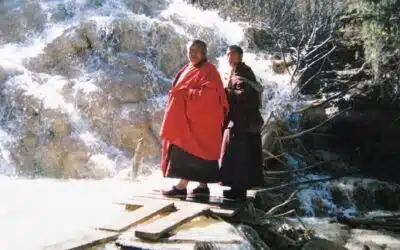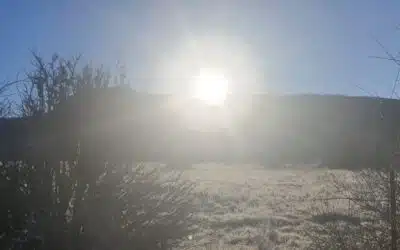The Five Degenerations – part 1

Written By Paul Baffier
Blog | History of Dzogchen | Reflections on life | The Dzogchen basics
“The Five Degenerations” is a tool for understanding why we feel so bad these days, our eco-anxiety and the denial that goes with it.
Series: Difficult conditions in Dzogchen
The Five Degenerations
The ‘Five Degenerations’ is a great classical theme of the Indo-Tibetan tradition, the context in which Dzogchen emerged.
It is translated as ‘Five Degenerations’ (snyigs ma lnga) because the tradition envisions the cycles of evolution and devolution of the conditions of beings in the universe over a long… very long time. This is a far cry from nostalgia for the society before the oil crisis, before May 68 or before the American and French revolutions, for example!
If you’re used to zombie movies and the post-apo genre in general, you’ll be in your element. On the other hand, it’s clear that this kind of cultural reference is quite far removed from our progressive and positivist imagination, in which it is envisaged that the concert of intelligences make it possible to build a better and fairer world.
The ‘Five Degenerations’ are a reflection, a tool for understanding why we feel so bad these days, our collective eco-anxiety (Solastalgia and Dzogchen) and the denial that goes with it.
These ‘five degenerations’ are: lifespan-vitality (tshe), passions (nyon mongs), the merits or activities (las) of beings (sems can), the time (dus) and view (lta ba).
“If you’re used to zombie movies and the post-apo genre in general, you’ll be in your element. On the other hand, it’s clear that this kind of cultural reference is quite far removed from our progressive and positivist imagination, in which it is envisaged that the concert of intelligences make it possible to build a better and fairer world.”
To give some context, let’s start with the first two, time (dus) and lifespan (tshe):
Time (dus)
Tradition speaks of snyigs dus, which could be translated as ‘rotten age’, because snyigs also means ‘rubbish’; sometimes we find rtsod dus, ‘age of strife’. These terms draw on the ancient cultural background of Indian thought about the four ages: there was a distant golden age when there was no sun or moon in the sky and all humans, immensely tall and miraculously moving through space, were illuminated by their own natural luminosity and fed on divine nectar. Their emotions and actions degenerated over the millennia through two more ages… until our time, the last age, when this process is accelerating and, according to certain prophecies, Dzogchen is the most appropriate teaching for beings.
Lifespan-vitality (tshe)
According to tradition, lifespan gradually diminished. At the time of the reign of the universal monarch Daḷhanemi, Human beings lived for eighty thousand years [1]. But because the seventh successor of Daḷhanemi lost the understanding of the ritual of the Universal Wheel, not knowing his royal duties, he began to rule ‘according to his own ideas’, which led to the decline of the kingdoms. In particular, he did not give money to the poor, which led to greater poverty, which led to theft, which led to the use of weapons, which led to murder, which reduced the lifespan of the children of those who were our first ancestors.
Their lifespan decreased to forty thousand years.
Then lifespan was shortened, because of lying, to twenty thousand years.
This lifespan was shortened, by backbiting, to ten thousand years.
Then lifespan was shortened, by sexual misconduct, to five thousand years.
Then lifespan was shortened, by harsh and superficial words, to two thousand five hundred years.
Then lifespan was shortened, by anger and desire for the possessions of others, to one thousand years.
Then lifespan was shortened, because of false views [2], to five hundred years.
Then lifespan was shortened, because of false beliefs, uncontrolled desire and greed, and decreased to two hundred and fifty years.
Lifespan was then shortened, because of lack of care for parents and lack of respect for holders of knowledge, to one hundred years… in 2025, the people’s lifespan will be around eighty years for men and eighty-four years for women in Europe (according to statistics from the Institut National d’Études Démographiques, figures for 2023, in French).
In our time, we are plasticizing nature (French), which can lead to famine, and we are destroying our ecosystem, and therefore our vitality.
According to traditional forecasts, our life expectancy will decrease even further, to only ten years. Acts of kindness even between parents and children, will disappear until we forget the vocabulary of kindness and any concept associated with it.
Then, these human beings who will be our descendants, reduced to an almost animal stage, will hunt each other furiously with knives, screaming. Only a few will hide in isolated places, and then they’ll have a really good idea:
‘Let’s not kill anyone anymore’.
Little by little, they will rebuild the bonds of brotherhood and their children will live for twenty years… who will again do good deeds that will cause their children to live for forty years… and so on, up to eighty thousand years.
Patrul Rinpoche gives a summary in ‘Words of My Perfect Teacher’ (chapter ‘Other examples of impermanence’), an essential book on Dzogchen, but if you want to read its source, read The Sutra of the Universal Monarch, a beautiful program in which the apocalypse, having reached its final stage, ends up beginning again in the opposite direction, in a cyclical conception of time so vast that it makes you dizzy… and broadens the horizon of our present action.
To be followed for the three remaining degenerations: the passions (nyon mongs), the merits of beings (sems can), and view (lta ba).
[1] Although the term means “years,” it actually refers to periods of growth and decline associated with the appearance of an awakened being or the action of harmful beings. BACK
[2] False view: in Tibetan ‘log lta’ (Sanskrit: mithyā-dṛṣṭi), which means rejecting the law of causality (consequences and interdependence of our actions) and ignoring their empty nature by belief in their non-existence (nihilism) or existence (eternalism). BACK
More Posts
A Garland of Light
In “A Garland of Light”, Johanne talks about the way the lineage of the Great Perfection is passed on, since its beginning.
Stories When the Light Fades
In “Stories When the Light Fades”, Mila Khyentse recalls some of his Master’s Jack-o’-lantern stories told at night.
The ground (gzhi)
This article is the first in a new category designed to provide a better understanding of the essential words and concepts of Dzogchen.




